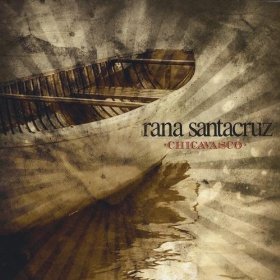Rana Santacruz will be performing at Old Town School of Folk Music January 5, and Sound Culture Center for Global Arts brings him to the Mayne Stage on January 8.
“You could call it, like, Mexican bluegrass”, responds Rana Santacruz, when I ask him to describe his music. Having played and really enjoyed his solo debut album, “Chicavasco”, for several months now, I counter that it seems much too limiting a description for his ballads, and the sweet surprises of melodies and rhythms they contain. His music is not quite like anything you have heard before, yet at the same time it seems so very familiar, particularly if you have experienced the aesthetics of a Mexico that is in touch with its colonial roots – neither European nor indigenous, but both, and accompanied by a genteel, sentimental sense of beauty and romance.
I was curious as to how Santacruz came to create his unique brand of alternative Mexican folk music. Speaking from his home in New York City, he has an easy laugh and a wry sense of humor that also comes across in his lyrics. Born in Mexico City, his musical path started without much direct musical schooling, although he comments, already in kindergarten, the teacher reported to his mom that he spent most of the day at school singing. There was always music playing in the home, and some of his fondest memories are family gatherings which took off when both the tequila and the “Musipistas” (karaoke-like soundtracks on vinyl records) came out and started the sing-along.
Much like Mexican folk music which easily ingests disparate influences as cultures cross countries by choice or by chance, Santacruz´s musical project now encompasses many of the elements that have interested him along the way. He first started with the guitar and a band that covered post-punk eighties British rock. A trip to New Orlean resulted in falling in love with folk music and the banjo, so he transformed that same band into an alternative folk-rock band called “La Catrina”, which amicably disbanded after being signed by Warner and completing a semi-successful but wearying recording and touring experience. Santacruz also at some point began playing the accordion, after finding one in a friend´s grandfather´s house.
His current group incorporates violin, accordion, bass, trumpet, banjo, jarana (small guitar-shaped instrument) and other instruments which appear in the different folkloric genres of Mexican music. The lyrics of his songs, though not necessary to enjoy the music, are moments of delightful storytelling with a touch of magical realism – no surprise, Santacruz was reading Gabriel Garcia Marquez at the point that he was creating “Chicavasco.”
Where will his path lead to next, I wonder? Santacruz answers that what is most important to him is integrity as an artist – a personality and a signature that is unique, and a sound that is true. His conscience will dictate, he adds, whether or not to incorporate a brighter, brassier sound and percussiveness to his compositions (something he is considering) but ultimately, he affirms: “Music for dancing and for partying is quite popular today. You can certainly dance to some of my music, but I want to create music that touches deep feelings – happiness, sadness. More than anything, for me, it´s about sharing an emotional connection.”
